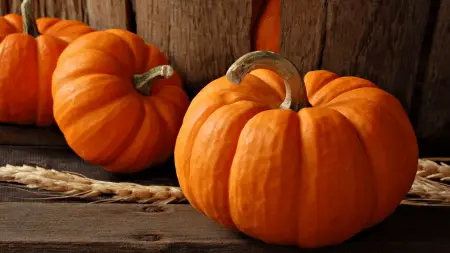Would you believe it if someone tells you that big, round, orange vegetable you see during the Halloween season is a squash? You’d probably say they are wrong because it’s a “pumpkin” and not a “squash.” So what is really the difference between a pumpkin and a squash? This article will discuss the difference the two.
Summary Table
| Pumpkin | Squash |
| A common term used to refer to any round, orange squash (mostly belonging to the species Cucurbita pepo and Cucurbita maxima) | Any edible herbaceous vine that belongs to the Cucurbitaceae family; its color and shape can vary depending on its species |
| Can be eaten and also be used as a decoration for autumn | Mainly used for culinary purposes and infrequently used as an ornament |
Descriptions

The term pumpkin actually has no botanical definition. It is a generic term that refers to any round orange squash usually belonging to the species Cucurbita pepo and Cucurbita maxima.
A pumpkin has a thick, ribbed, smooth shell. Its inner layer has seeds and is pulpy. It is usually dark yellow or deep orange and can weigh from 6-18 pounds. Its stem is woody and furrowed.
Most parts of the pumpkin are edible. Its shell, flesh, seeds, flowers, and even leaves can be eaten. In general, a pumpkin is 92% water, 6.5% carbohydrates, and the rest is fat and protein. It is a great source of vitamin A and beta-carotene (which gives it the deep orange color). It also contains a moderate content of vitamin C and traces of fiber, calcium, and potassium.
The pumpkin is the main ingredient in pumpkin pies, which is a traditional food usually served during Thanksgiving in the United States and Canada. It is also great for pumpkin soup and pumpkin bread. However, aside from its culinary purpose, it can also be used as an animal feed or an ornament, especially during the autumn. During the Halloween, pumpkins are carved into different designs and are called jack-o-lanterns.

On the other hand, a squash is an edible herbaceous vine that belongs to the Cucurbitaceae family. It is scientifically called Cucurbita. It produces large and fleshy fruits. The fruits’ shape and color vary depending on the species. There are two main types of squash:
- Summer squash – zucchini, pattypan, crookneck, and straightneck squash
- Winter squash – cushaws, hubbards, butternut, and banana squash
The squash is a great source of vitamin A, vitamin C, cucurmosin, cucurbitacin, and cucurbitin. Although it is famous for soups, it is actually very versatile and can also be baked, roasted, or sautéed.
Pumpkin vs Squash
What, then, is the difference between a pumpkin and a squash?
The word “pumpkin” does not have any botanical meaning but is actually a common term used to refer to any round, orange squash (mostly belonging to the species Cucurbita pepo and Cucurbita maxima). Conversely, a squash is any edible herbaceous vine that belongs to the Cucurbitaceae family. Its color and shape can vary depending on its species. In other words, a pumpkin is a squash but not all squash are pumpkins.
Both are fleshy, delicious, and nutritious. However, aside from its culinary purposes, a pumpkin can also be used as a decoration especially during autumn and Halloween. The squash is mainly used for culinary purposes and is not as commonly used as an ornament.
Origins & Varieties
Pumpkins originally came from North America about 9,000 years ago. They were an essential fruit for Native Americans. The term “pumpkin” usually brings to mind those round, orange pumpkins used for pie and Jack-o-lanterns. However, there are many types of pumpkins that come in a wide range of colors.
Squash also comes from the Americas, where it was a staple for many Native Americans.
Taste & Texture
Pumpkins are usually sweet, with a slight earthy flavor. Their flavor becomes more intense when roasted or cooked. The pumpkin’s flesh becomes soft and easy to mash or blend into other dishes (such as soups, pies, etc.). The most common pumpkin spices include cinnamon, nutmeg, and cloves.
The taste of squash can vary greatly depending on the variety of squash. For instance, winter squashes (such as butternut) have a nutty, slightly sweet flavor that intensifies when cooked. The texture of the flesh is different from pumpkins—it is more dense and creamier.
Summer squash usually has a mild, more delicate taste, with tender flesh that is not fibrous.
Versatility
Both pumpkins and squashes are very versatile for cooking. For instance, pumpkins make amazing pies and muffins, while summer squash is usually best grilled, sautéed, or baked. Winter squash is often used in soups, stews, and roasted vegetable mixes.
Size & Appearance
Pumpkins vary in appearance; however, they are usually larger and rounder than squash. Squash tends to come in various colors, shapes, and sizes.
FAQs
Are pumpkins vegetables?
No, pumpkins and squash are fruits, not veggies.
Is squash pumpkin or pumpkin squash?
Pumpkins are a type of winter squash.
Which is better—canned pumpkin or homemade pumpkin puree?
Homemade pumpkin puree is easy to make and contains 100% pumpkin. On the other hand, canned pumpkin may contain other types of squash, and it’s usually more expensive than homemade pumpkin puree.





